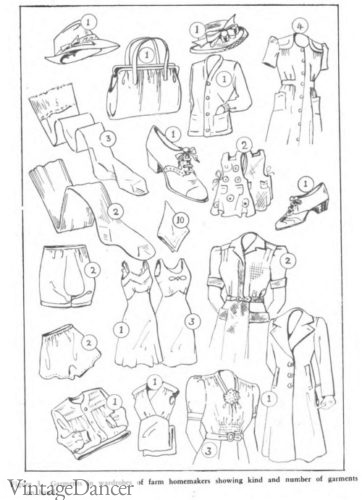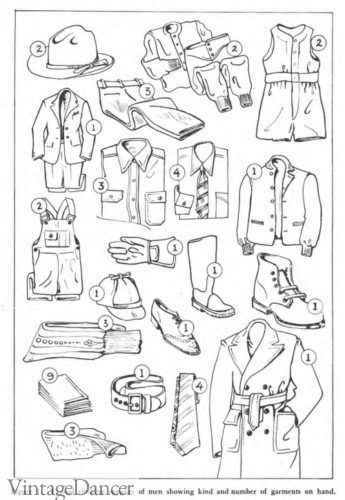What is in your closet? The number of clothing we have today is massive compared to the limited wardrobes in the 1940s. With smaller incomes, higher quality clothing, less variety of clothing, and more home sewing skills, the pre-fast fashion years were one of careful planning and dedication to wearing clothes out completely.
So, what was in a 1940s capsule wardrobe? How many clothes did men and women need to purchase every year? How should I build an authentic 1940s clothing plan?
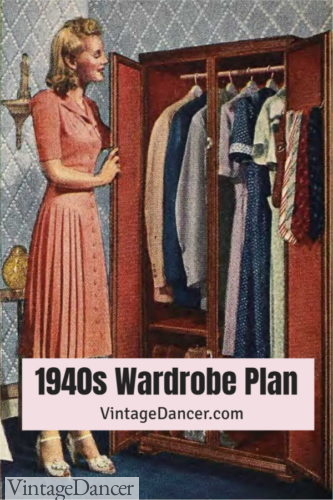
The difference between classes – working farmers vs. middle class city families in the USA- was surprisingly little. More income only meant spending more on clothing items, not necessarily buying more of them.
The exception was young, single women, who spent more on dresses, shoes and hats every year than any other age group. Upper classes also bought more variety of clothing, specialty clothing (Sports), and formal wear.
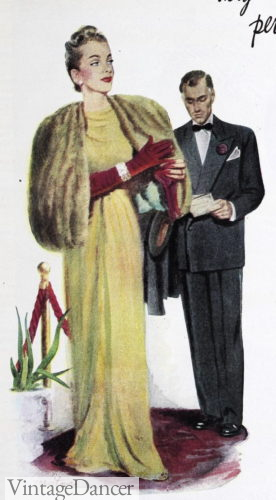
1947 evening fur cape
Men’s 1940s clothing usually cost more than women’s, but lasted longer and was purchased less often. Working classes spent more time sewing and repairing clothing at home, a task required even more so during Wartime.
“Make do and Mend” was the moto of the decade. Men’s clothing was almost never homemade during the 1940s except for knitwear like socks, vests and sweaters.
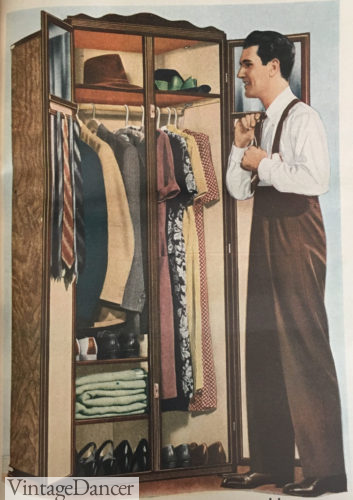
1942 men and women’s wardrobe
Clothing was replaced only as needed, not because the fashion trends changed. Most major garments like dresses and suits were purchased every 2 years. Clothing was also repaired, cleaned or shaped (hats), which also took a bit of the clothing budget each year. High-use items such as hosiery were purchased frequently throughout the year.
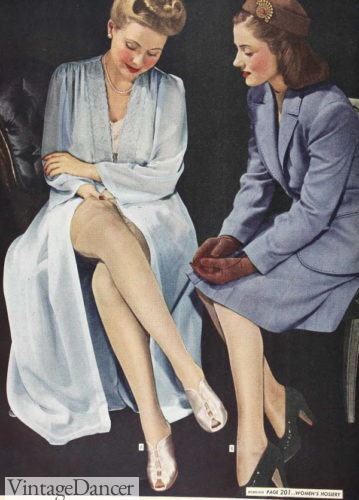
1945 sheer stockings
Underwear, however, was not replaced as often as I expected. Men and women only had a few pairs in their drawer at a time, possibly re-wearing them several times before going to the wash. They were made significantly better and lasted longer than our underwear today, but still, I’m a little grossed-out.
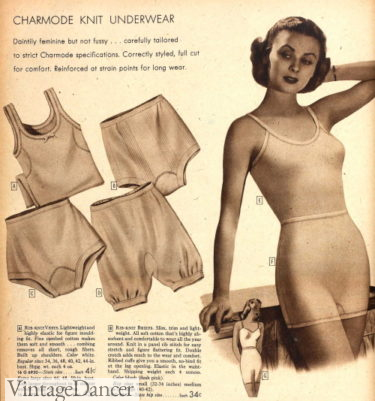
1946 knit underwear
Of the capsule lists below, there are some items missing. Specialty sportswear was purchased by the classes that could afford it, but never made it to these lists. Certain styles of clothing such as a specific jacket or type of negligee might have been lumped into a general category.
Women’s lingerie, too, had so much variety and personal preference that the lists are generalized and not very specific. Clothing for special occasions such as travel, weddings, summer vacations, and school uniforms are also missing.
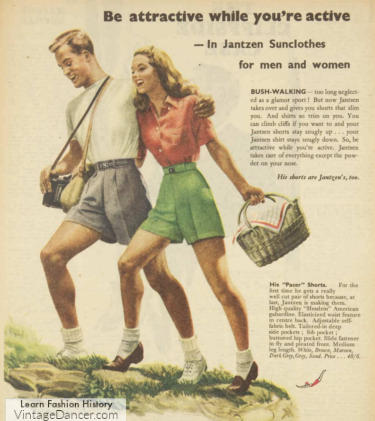
1948 casual hiking outfits
The final things to note about these lists is that most are compilations of clothing that were purchased each year (or every few years). A person certainly had more than these items in their wardrobe at any given time. Everything was worn until it was no longer usable.
For example, a man’s new hat was saved for special occasions and his old hat became his working hat. A woman’s old street dress became a house dress before it was eventually made into an apron or children’s clothing. Hats were re-trimmed. Shoes were re-soled and heels replaced several times a year. Many smaller items were never purchased because they were given as gifts at Christmas.
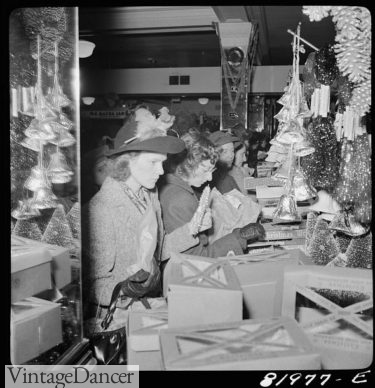
1941 shopping at Christmas
1940s Capsule Clothing Plan
The 1940s put the world back at war with wartime restrictions and limitations. Once again, women and men had to make do and mend what they had, wear uniforms, shop frugally, and sew more from scratch. Only 10% of income was spent on clothing. Less was spent on lingerie or specialty items like raincoats.
Free clothing such as floursack dresses and aprons helped stretch a budget. Church charity bins were necessary places to shop for the struggling family.
A moderately priced and purchased dress was expected to last 1.5 to 2 years. Poor women mended more often instead of replacing clothing, expecting good dresses to last 2-3 years before being recycled into aprons and children’s clothes.
- 1942 woman’s clothing plan
- 1942 men’s clothing pan
VintageDancer has a full history of the 1940s fashion for women and men. Here are a few articles to get you started.
- What Did Women Wear in the 1940s? 40s Fashion Trends
- 1940s Men’s Fashion History and Clothing Styles
- 1940s Dress Styles- Casual to Cocktail
- 1940s Men’s Casual Clothing
- 1940s Shoes Styles for Women History and for men
On to the 1940s wardrobe lists!
1942 Farmer’s Wife – Capsule Wardrobe
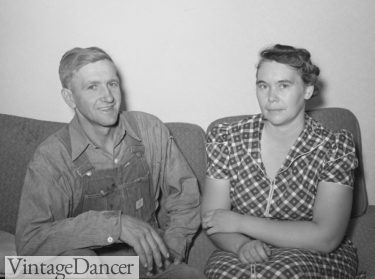
1940 farmer and wife
A farmers wife would have been on the poorer spectrum of women in the 1940s. Her wardrobe revolved around housework, gardening, grocery shopping and attending church. She lived in her cotton house dresses and apron.
Her church outfit would have been her nicest dress, hat and stockings. These were simple rayon dresses, sometimes a newer cotton housedress if that’s all she could afford.
- Hats – 1 straw, 1 felt. $1-3 dollars. Shop hats.
- Purses – 1. $2-4 dollars each.
- Knitwear – 1 cardigan sweater. Shop sweaters.
- Dresses – 2-3 rayon dresses, 2-3 cotton day dresses, 2-4 cotton house dresses. Shop day dresses.
- Underwear – 2-3 slips, 4 panties. Shop lingerie.
- Coats – 1. Shop coats.
- Nightgowns – 2. One winter, one summer. Shop nightgowns.
- Hosiery – 4-5 pairs for summer and winter. Shop stockings.
- Shoes – 1 pair nice shoes, 1 pair work shoes. Shop shoes.
- Handkerchiefs – 6-10.
- Aprons – 2.
These would be a mix of purchased, handmade, and up-cycled garments. Also a mix of seasonal items.
Notice that there are no pants/trousers. These would have been inventoried under her husband’s clothing count because she would “borrow” his pants, overalls, gloves, and rubber boots to do farm-work. Otherwise, she did everything in a house dress and apron.
Watch this video reel with examples of a housewife’s wardrobe from 1942:
1942 Farmer Man (low to middle class) – Capsule Wardrobe
The 1940s farmer (male) would have worn the same workwear clothes all week, only changing into nicer clothes for Sunday church and then back to workwear. His heavy duty overalls or trousers with sturdy workshirt and pair of boots kept him reasonably clothed through the seasons.
- Hats – 1-2 felt hats, 1 straw hat or cap. Shop hats.
- Coat – 1 winter overcoat, 2 other outerwear (sweater, light jacket).
- Suits – 1-2 wool suits. Shop suits.
- Trousers – 2-4 cotton. Shop pants / trousers.
- Overalls – 2.
- Shirts – 2-3 work shirts, 1-4 cotton shirts. Shop shirts and knotwear.
- Underwear – 2-3 union suits , 1-3 summer underwear sets.
- Pajamas – 2 if middle class, none for lower classes.
- Socks – 2-4 cotton, 1-3 rayon.
- Shoes – 1 work boots, 1 dress shoes, 1 rubber boots. Shop shoes.
- Handkerchiefs – 3-8.
- Ties – 2-3 if middle class.
- Belts – 1-2.
- Gloves – 1 work pair for lower classes.
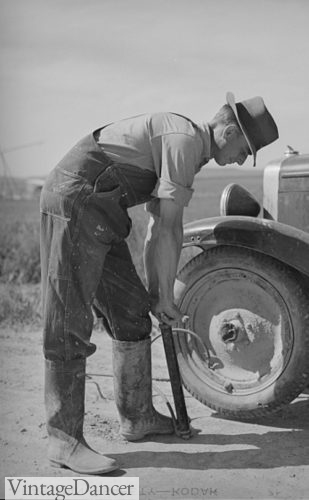
1941 farmer fixing a tire
1942 Married Woman (low to middle class) – Capsule Wardrobe
A middle class 1940s woman had a bit more expendable income and time to read about the latest fashions. She may have purchase new dresses from a local shop or mail order catalog. Her selection of clothing wasn’t any different than that of a farmer’s wife, just a bit more of it and a higher quality.
While she tended to chores during the day she may have had more time to visit with friends, volunteer for charity, or work a part time job. She would dress well but frugal for these public occasions.
- Hats – 1 straw, 1 felt. Hat history.
- Dresses – 2-4 nicer rayon dresses, 1-2 cotton day dresses, 2-4 cotton house dresses.
- Coat – 1 without fur, 1 wrap/shawl. None for poorest.
- Suits – 1 suit or light coat.
- Nightgowns – 2-3. History of sleepwear.
- Panties – 1-2 cotton, 2-3 rayon.
- Slips – 2 cotton, 1-2 rayon.
- Hosiery – 2 cotton, 1-2 rayon.
- Shoes – 1-2 pairs dress shoes, 1 pair work/home shoes.
- Handkerchiefs – 3-6.
- Aprons – 2.
- Purses – 1-2. History of handbags.
- Jewelry– none mention but I’m sure there were some basics.
- Source
- *again no pants/trousers were listed but many young women wore a pair of casual trousers on the weekends. It was still a taboo item of clothing which is why women either left them off the survey or the surveys never asked women to identify if they owned them.
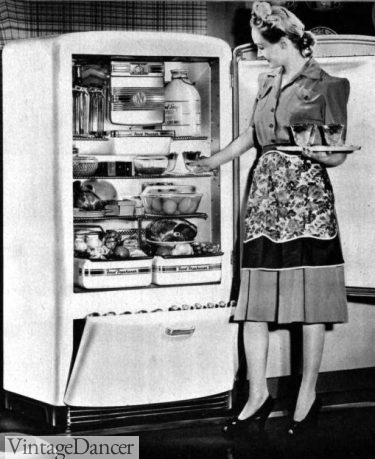
1941 middle class housewife
1949 Wealthier City Girl /Teenager – Capsule Wardrobe
1940s teenager girls who were always the most expensive to cloth. They had the most interest in new fashions and the most desire to follow trends. They also grew fast and needed new clothing frequently.
Teens wore casual clothes (shorts, rompers, jeans, playsuits) for activities outside of school. This only added to their vast wardrobe compared to their mother’s.
Wealthier women would have had similar capsule wardrobes with additional jewelry, accessories, and furs.
- Coats – 2 coats, 1 raincoat.
- Suits – 1 suit, 2 jackets.
- Hats – 4.
- Scarves – 1.
- Dresses – 10. A mix of daytime and party dresses.
- Separates – 2 skirts, 2 blouses.
- Shoes – 9 (boots and slippers included).
- Hosiery – 4 hose, 10 socks.
- Playsuits – 2 playsuits, 1 pantsuit, 1 swimsuit. Shop playsuits.
- Sleepwear – 2 robes, 3 pajamas.
- Underwear – 4 slips, 4 panties.
- Lingerie – 4 brassiere, 1 girdle.
- Gloves – 4.
- Purses – 2.
- Handkerchief – 12.
- Several pieces of jewelry.
The city girl’s clothing lasted longer than a farmer because she had more wardrobe to circulate through, as well as the ability to purchase higher quality garments.
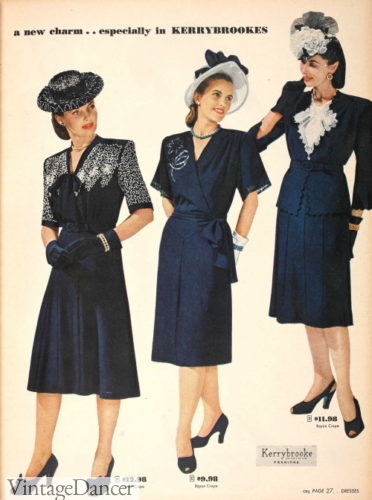
1948 navy blue lace trim afternoon and party dresses
Creating a 1940s Capsule Wardrobe Today
A modern man or women with a flair for the 1940s aesthetic can create a wearable 1940s capsule wardrobe plan using genuine vintage ($$$), 1940s reproduction clothing($$), or affordable vintage inspired clothing($). Using the lists above I created a plan for a middle class woman and man.
1940s Capsule Plan for Women
- 10 dresses – A mix of cotton house dresses(4), going out rayon dresses(2), and party frocks (3). 1 suit instead of a dress, if you wish.
- 1 winter coat
- 1 sweater/cardigan
- 2 blouses
- 1-2 skirts
- 1 pair of nice pants/trousers or workwear denim blue jeans/overalls
- 2 shoes – 1 low heel oxford shoes and 1 dress heels (additional shoes, sandals and winter boots are optional)
- 2 hats – one all season hat and 1 straw summer hat
- 5 stockings – 2 backseam sheer stockings, 3 winter weight knit stockings or tall socks
- 2 bras, 1 girdle/corset/garter belt
- 5 panties – 3 cotton panties, 2 silky tap pants ( Personally, I would buy more cotton panties )
- 3 slips – silky slips or winter knit slips for colder climates
- 2 nights gowns – 1 summer nightgown, 1 winter pajama, and 1 house slippers
- 1 purse
Optional items (that have less use today as they did in the 1940s)
- 10 Handkerchiefs
- 2 Aprons
1940s Capsule Plan for Men
The men’s wardrobe largely depends on one’s occupation. Working class/blue collar careers need work clothing that suits the job whereas a professional office job required more suits and dress clothes.
- 1-3 suits- Only 1 for working class, 2-3 suits for professional class (in winter and summer weight fabrics). A sportscoat could be a substitute for 1 suit.
- 1 coat – A trench coat is a good choice
- 1 – casual jacket / work jacket
- 2 hats – felt fedora for winter and straw hat for summer
- 4 dress shirts and ties
- 3 casual / work shirts
- 2 overalls or jeans for working class / trousers for professional class
- Working class would need 1 work boots, 1 rubber boots, 1 gloves, 1 work hat
- 6 socks for work or dress
- 1 belt/suspenders
- 9 handkerchiefs
- 2 winter union suits and 2 summer union suits (these are both underwear and pajamas) or 3 boxers and undershirts and 1 pair of pajamas
How much did 1940s Clothing cost?
Using an inflation calculator USA $1 dollar is about $16 dollars in 2022. The prices change depending on current dollar values as well as what year you use in the 1940s. For these prices I put in 1945, the end of the war.
- Hat= $20-40
- Gloves= $10-20
- Simple Dress= $70-130
- Men’ Suit = $600-900
- Shoes = $100-150
- 1 yard of cotton fabric= $2-3
With the exception of fabric, you can see the prices of clothing are similar to today’s values. Since fast fashion became trendy in the 1960s, our clothing has become cheaper but also lasts a lot less longer. 1940s clothing, even the cheapest options, were built to last a few lifetimes.
Here are a few examples of clothing costs…
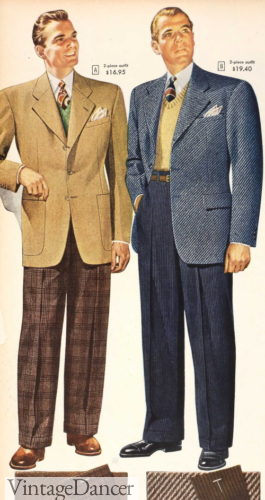
Wool Sportscoat and slacks at Sears – $17-20 or $280-$336 today
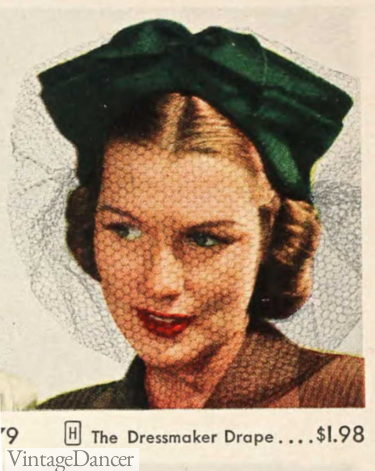
Wool felt hat with veil $1.98 or $33 today
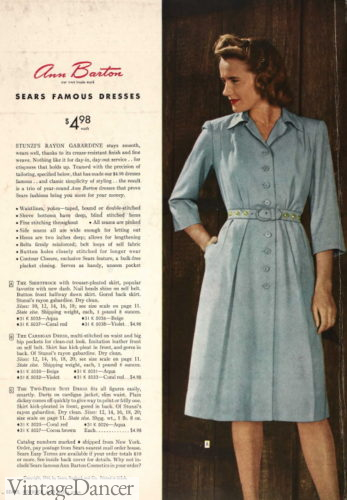
1944 rayon shirtdress. $4.98 or $83.83 today
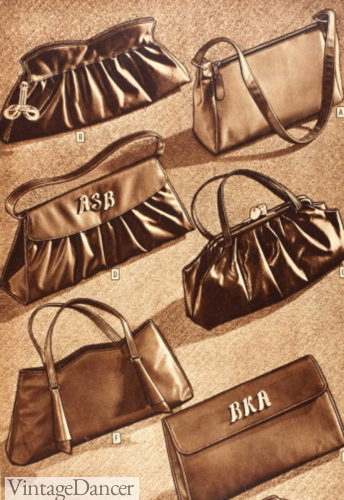
1944 artificial leather purses for $4.98 or $60.43
Other Capsule Decades
1910s Capsule Wardrobe & What Clothing Cost
1920s & 1930s Vintage Capsule Wardrobes
1950s & 1960s Capsule Wardrobes- What Clothing Women and Men Owned
Debbie Sessions has been teaching fashion history and helping people dress for vintage themed events since 2009. She has turned a hobby into VintageDancer.com with hundreds of well researched articles and hand picked links to vintage inspired clothing online. She aims to make dressing accurately (or not) an affordable option for all. Oh, and she dances too.
